Aug 02, 2006
Urban Tapestries

Urban Tapestries aims to enable people to become authors of the environment around them – Mass Observation for the 21st Century. Like the founders of Mass Observation in the 1930s, we are interested creating opportunities for an "anthropology of ourselves" – adopting and adapting new and emerging technologies for creating and sharing everyday knowledge and experience; building up organic, collective memories that trace and embellish different kinds of relationships across places, time and communities.
It is part of an ongoing research programme of experiments with local groups and communities called Social Tapestries.
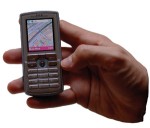
10:23 Posted in Information visualization, Telepresence & virtual presence, Wearable & mobile | Permalink | Comments (0) | Tags: locative media
Jul 25, 2006
UK youth addicted to mobile phones
Re-blogged from Smart Mobs
Young people value their mobile phone more than television, a new study has found. The survey, conducted by the LondonSchool of Economics and CarphoneWarehouse, polled over 16,500 young people in the UK to find out how mobile phones have changed the way we live.
Over a quarter of people aged 18-24 highlighted their mobile phone as more important than the internet, TV, MP3 player and games console. Only 11 per cent chose TV, while nearly half voted for the internet.
VNUnet has the complete story
22:32 Posted in Wearable & mobile | Permalink | Comments (0)
Jul 24, 2006
Mobile Persuasion 06
BJ Fogg's Persuasive Technology Lab (Stanford University) is sponsoring Mobile Persuasion 06, a one-day conference on how mobile technology can change people's beliefs and behaviors.

From the conference website:
Mobile Persuasion is for innovators, researchers, and companies creating mobile technologies that change people’s beliefs and behaviors. Applications include health, commerce, activism, social networking, addiction, advertising, gaming, and environmental conservation. This full-day event will feature expert presentations and panels on how mobile technology can change attitudes and behaviors.
The event will take place November 10th at Stanford University. Free registration is available for a limited time.
21:45 Posted in Persuasive technology, Wearable & mobile | Permalink | Comments (0) | Tags: persuasive technology
New remote monitoring system by FitSense Technology
Via Medical Connectivity Consulting
FitSense Technology's ActiHealth Intelligent Network provides an end to end system that collects, transports and presents physiological data automatically. Data that can be viewed instantly by the user as they go through their day. In the ActiHealth network, the body sensors monitor several health indexes, including physical activity, calorie burn, weight, body fat, blood pressure, blood glucose, heart rate.

According to the company, the system can be used in a range of health care applications, such as programs for weight management, health & wellness, and disease management.
18:34 Posted in Wearable & mobile | Permalink | Comments (0)
Biosensor watch: Exmocare
Via Medgadget
The Exmocare system is comprised of a wireless connectivity-enabled wristwatch which monitors the wearer's heartrate, galvanic skin response, and motion - 24 hours a day. The watch transmits this data via Bluetooth wireless up to 300 feet to the wearer's computer, or Exmocare-enabled mobile device. This device, in turn, uploads the data to the Exmocare data center by way of the ExmoReporter software.
In addition to the PC-based ExmoReporter software, the complete Exmocare system also provides ExmoReporter Mobile Edition, which reports from your Bluetooth-enabled Windows Mobile Smart Phone, and the Exmocare Car Kit, which reports physiological and emotional data correlated with GPS location and vehicle speed data from the wristwatch-wearer's automobile, allowing for a mobile Personal Area Network that moves with the wristwatch-wearer wherever she or he goes.

Once the wristwatch reports, the Exmocare system interprets the sensor data and assesses the emotional and physical activity of the wristwatch wearer. The system can detect up to 10 different emotional states, in addition to the level of physical activity of the wearer.The Exmocare system stores this data, along with the correlated raw data from the sensor. If something is out of the ordinary with the wristwatch wearer, Exmocare will send you an alert immediately by email, on your cell phone, or by instant message.
At any time you can also log into the website to see the data and correlated emotional state. Additionally, you can install the Exmonitor program on your Windows computer, which allows you to effortlessly monitor your loved one from your Windows taskbar, at home or at work.
18:10 Posted in Wearable & mobile | Permalink | Comments (0)
Jul 20, 2006
CatchBob
From the project's website
CatchBob is an experimental platform to elicit collaborative behavior of people working together on a mobile activity. Running on a mobile device (iPAQ, TabletPc), it's a collaborative hunt in which groups of three persons have to find and circle a virtual object on our campus.
Videos of CatchBob!:
- The long video (3:30, .mov, 15.8Mb) can be downloaded here.
- The short version (1:20, .mov, 8.3Mb) can be downloaded there.


19:30 Posted in Augmented/mixed reality, Creativity and computers, Wearable & mobile | Permalink | Comments (0) | Tags: computer supported collaborative work
New Google3D concept
Re-blogged from Smart Mobs

19:05 Posted in Virtual worlds, Wearable & mobile | Permalink | Comments (0) | Tags: virtual reality
Jul 17, 2006
Cellphones could soon have a tactile display
Via New Scientist
According to New Scientist, haptic devices (i.e. devices that stimulate our sense of touch) will add a new dimension to communications, entertainment and computer control for everybody, and for people with visual impairment they promise to transform everyday life. One proposed device consists of a headband that imprints the shape of objects in front of it onto the wearer's forehead, something that visually impaired people could find a great help when navigating though a cluttered environment. Moreover, cellphones could soon have a tactile "display", for example, and portable gadgets containing a GPSdevice will be able to nudge you towards your desired destination.
Read the full article
23:55 Posted in Wearable & mobile | Permalink | Comments (0) | Tags: virtual reality
Jul 05, 2006
Handheld Augmented Reality
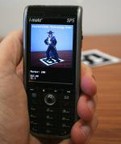 Handheld Augmented Reality: A standard, off-the-shelf Personal Digital Assistant (PDA) constitutes a cost-effective and lightweight hardware platform for Augmented Reality (AR). A PDA provides a simple, well-known user interface, and is fully equipped with a touch-screen and camera for providing a video see-through Magic Lens metaphor of interaction. In our Handheld AR framework, all interactive processing is done exclusively on the PDA without relying on a server infrastructure, which makes this solution highly scalable. Because of the low cost and suitable ergonomic properties of the PDA platform, massive multi-user AR application become possible for the first time.
Handheld Augmented Reality: A standard, off-the-shelf Personal Digital Assistant (PDA) constitutes a cost-effective and lightweight hardware platform for Augmented Reality (AR). A PDA provides a simple, well-known user interface, and is fully equipped with a touch-screen and camera for providing a video see-through Magic Lens metaphor of interaction. In our Handheld AR framework, all interactive processing is done exclusively on the PDA without relying on a server infrastructure, which makes this solution highly scalable. Because of the low cost and suitable ergonomic properties of the PDA platform, massive multi-user AR application become possible for the first time.23:32 Posted in Augmented/mixed reality, Wearable & mobile | Permalink | Comments (0) | Tags: augmented reality
Jul 03, 2006
Cell phone emissions excite the brain cortex
More than 500 million people in the world use cell phones which emit electromagnetic fields (EMFs). Though many studies have looked at the effects of EMFs on the body, few have focused on their effects on the brain. Such effects could be harmful, neutral, or beneficial and might be particularly important for individuals with conditions involving cortical excitability, such as epilepsy.
Researchers in Italy, led by Paolo M. Rossini, M.D., Ph.D. of Fatebenefratelli, used Transcranial Magnetic Stimulation (TMS) to investigate brain function under exposure to electromagnetic fields from a common type of cell phone. Their study reports the effects of EMF exposure on brain physiology for the first time.
The researchers developed a double-blind study in which 15 young male volunteers were exposed to EMF signals from a GSM 900 cell phone for 45 minutes. They measured Motor Evoked Potentials (MEPs) during motor cortex TMS before, and immediately after EMF exposure, and also one hour later.
In 12 of the 15 subjects, the data showed an excitability change in the motor cortex adjacent to the cell phone. "Intracortical excitability was significantly modified, short intracortical inhibition was reduced and facilitation enhanced," the authors report. They found that the effects of the EMF were transient and the subjects' brains tended to return toward baseline conditions one hour after the exposure.
It would be premature to presume that this work implies that using a cell phone is bad for the brain in any way. Much more work needs to be done to understand whether these electrical changes in the brain make any difference whatsoever in the way we think or in any disease process in which cortical excitability is affected.
Article: "Mobile phone emissions and human brain excitability." Ferreri, Florinda; Curcio, Giuseppe; Pasqualetti, Patrizio; De Gennaro, Luigi; Fini, Rita; Rossini, Paolo. Annals of Neurology; July 2006; (DOI: 10.1002/ana.20906 ).
Objective |
To test - via Transcranial Magnetic Stimulation (TMS) - the excitability of each brain hemisphere after  real real or or  sham sham exposure to the electromagnetic field (EMF) generated by a mobile phone operating in the Global System for Mobile Communication (GSM). exposure to the electromagnetic field (EMF) generated by a mobile phone operating in the Global System for Mobile Communication (GSM). |
Methods |
| Fifteen male volunteers attended two experimental sessions, one week apart, in a cross-over, double-blind paradigm. In one session the signal was turned ON (EMF-on, real exposure), in the other it was turned OFF (EMF-off, sham exposure), for 45 minutes. Motor Evoked Potentials (MEPs) were recorded using a paired-pulse paradigm (testing intracortical excitability with 1 to 17 ms interstimulus intervals), both before and at different times after exposure to the EMF. Short Intracortical Inhibition (SICI) and Facilitation (ICF) curves were evaluated both on the exposed and non-exposed hemispheres. Tympanic temperature was collected during each session. |
Results |
| The intracortical excitability curve becomes significantly modified during real exposure, with SICI being reduced and ICF enhanced in the acutely exposed brain hemisphere as compared to the contralateral, non-exposed hemisphere or to sham exposure. Tympanic temperature showed no significant main effect or interactions. |
23:39 Posted in Wearable & mobile | Permalink | Comments (0) | Tags: mobile phones
Jun 21, 2006
New wrist-worn Linux PC targets healthcare
Via Emerging Technology Trends
The Zypad WL 1000 is a new hands-free PC running Linux or Windows CE, which offers wireless networking and GPS tracking. It also includes a patented orientation sensor that can be configured to induce standby when the user's arm drops. According to the manufacter (Eurotech), the Zypad could be used by healthcare or law enforcement personnel.

Eurotech expects to have the product "on the shelf" in late July, priced at $2,500.
14:15 Posted in Wearable & mobile | Permalink | Comments (0) | Tags: wearable
May 22, 2006
Origami Cell Phone
 Via Pasta and Vinegar
Via Pasta and Vinegar The Origami Cell Phone is a future cell phone concept, which uses flexible e-paper to create a larger-than-cell display.
The concept was developed at Inventables, a consulting company specialized in "just about possible" applications.
23:03 Posted in Wearable & mobile | Permalink | Comments (0) | Tags: Positive Technology
May 15, 2006
Daegu to Launch 'Ubiquitous' Health Monitoring
From Smart Mobs
Daegu in South Korea "will be the first city in the country to provide a “ubiquitous” healthcare service in which so-called wearable computers will be used to monitor the health of elderly people living alone and patients with chronic diseases,"this article says."The devices,in the form of shirts,alert medical staff in real time when an emergency occurs.Daegu City said Thursday that it will launch its groundbreaking “U-Healthcare Service” in cooperation with the Ministry of Information and Communication.The city will distribute the bio-shirts to some 100 elderly people and patients with chronic diseases later this year.The shirts have embedded sensors that register vital signs and send the information to medical centers through the network. They also permit self-diagnosis, distance monitoring, emergency care and medical consultation for users in an environment of ubiquitous connectivity"
Daegu to Launch 'Ubiquitous' Health Monitoring
22:22 Posted in Wearable & mobile | Permalink | Comments (0) | Tags: Positive Technology
May 13, 2006
Phone shui

According to Unwired View, Motorola has recently put forth a patent for the Feng Shui Phone, which has the following functionalities:
- Three-dimensional Hall-effect sensor for measuring the strength of electromagnetic fields and to form a compass to determine the geographic direction in which the main wall of the house faces.
- Digital camera to determine color saturation, order and balance of the surroundings.
- GPS receiver to determine geographic location of the phone.
- The coordinates are then sent to the GIS databse through wireless network to to get the information about the surroundings of the location, e.g. the distance from the undesirable sites such as major airports, landfills, and factories.
- Cellphone microphone is used to measure noise level of the location.
- AM/FM radio to measure the AM and FM transmission strength and the distance form nearest AM/FM towers.
- The table with the chi values of each parameter is stored in phones memory and is used for calculation of chi values of different parameters.
19:27 Posted in Wearable & mobile | Permalink | Comments (0) | Tags: Positive Technology
May 10, 2006
Smartshirt
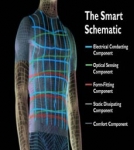
The company Sensatex is looking for beta testers for its SmartShirt System, a wearable physiological information management platform based on technology developed at the Georgia Institute of Technology.
From the website:
the SmartShirt is made using any type of fiber. It is woven or knitted incorporating a patented conductive fiber/sensor system designed specifically for the intended biometric information requirements. Heart rate, respiration, and body temperature are all calibrated and relayed in real time for analysis.
According to Sensatex, the shirt can be used to remotely monitor home-based patients, first responders, hazardous materials workers and soldiers. It also can be used to monitor signs of fatigue in truck drivers and to support athletic training.
21:53 Posted in Wearable & mobile | Permalink | Comments (0) | Tags: Positive Technology
May 07, 2006
Motorola Cell Phone Automatically Adjusts to the Elderly
Via Textually.org

Motorola has patented a new phone technology adaptable for the hearing impaired.
"By automatically detecting speech patterns of the elderly, the technology automatically boosts incoming and outgoing audio while simplifying menu structure and increasing font size.
The special needs of the elderly can often be in conflict with other users, such as the youth which often desire the smallest, most feature rich devices possible. Hence, the technology allows one device to adapt and accommodate to both market segments."
13:35 Posted in Wearable & mobile | Permalink | Comments (0) | Tags: Positive Technology
Mobile Processing Workshop: Interactive Applications for Mobile Phones
Lisbon, Portugal, 15 - 19 May 06, Espaço Atmosferas, Rua da Boavista, 67, Lisbon.
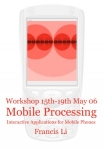
From the conference's website
The mobile phone has reached a level of adoption that far exceeds that of the personal computer. As a result, they are an emerging platform for new services and applications that have the potential to change the way we live and communicate.
Mobile Processing is an open source project that aims to drive this innovation by increasing the audience of potential designers and developers through a free, open source prototyping tool based on Processing and the open sharing of ideas and information. This workshop will introduce the Mobile Processing project and prototyping tool and provide hands-on instruction and experience with programming custom applications for the mobile phone.
Contents:
- Introduction to Mobile Processing, phone hardware and development platforms.
- Survey of projects with the phone as both the platform and subject for new forms of interactive applications and electronic art.
- Basic programming and prototyping concepts with 2D graphics and animation.
- Phone input/output handling including keyboard, camera, sound and vibration.
- Internet networking. Parsing and generating XML-formatted data.
- Text messaging and Bluetooth networking.
The workshop will be practical and at the end every participant will develop a personal exercise.
Equipment
Windows highly recommended, but Mac OS X is acceptable, with built-in or USB Bluetooth adapters recommended. Mobile phones with support for Java and Bluetooth recommended.
Participants are encouraged to bring their laptops.
Schedule
20 hours: 5 sessions X 4 h
15 to 19 of May 06 - 18h-22h
Target
Basic programming skills, familiarity with Processing recommended but not required.
13:16 Posted in Wearable & mobile | Permalink | Comments (0) | Tags: Positive Technology
Apr 27, 2006
Mobile phone may impair your ability to make snap decisions
From textually.org
Electromagnetic radiation from your mobile phone may impair your ability to make snap decisions, such as when driving a car, an Australian study shows, reports Optus.net via Engadget Mobile and Techdirt Wireless.
"The study, which will be published in the journal Neuropsychologia found evidence of slowed reactions, on both simple reactions and more complex reactions, such as choosing a response when there is more than one alternative.
The researchers found these effects after people were exposed to electromagnetic radiation equivalent to spending 30 minutes on the phone."
... Another interesting finding of the study was that the participants showed a slight improvement in working memory, such as remembering a phone number long enough to dial it."
23:07 Posted in Wearable & mobile | Permalink | Comments (0) | Tags: Positive Technology
Apr 12, 2006
Social Network Mnemonics for Teenagers
Nicolas Nova (Pasta and Vinegar) has found an article describing a a curious device: Telebeads: Social Network Mnemonics for Teenagers by Jean-Baptiste Labrune and Wendy Mackay (IDC2006)
From the article:
This article presents the design of Telebeads, a conceptual exploration of mobile mnemonic artefacts. Developed together with five 10-14 year olds across two participatory design sessions, we address the problem of social network massification by allowing teenagers to link individuals or groups with wearable objects such as handmade jewelery. We propose different concepts and scenarios using mixed-reality mobile interactions to augment crafted artefacts and describe a working prototype of a bluetooth luminous ring. We also discuss what such communication appliances may offer in the future with respect to interperception, experience networks and creativity analysis.
The ring addresses two primary functions requested by the teens: providing a physical instantiation of a particular person in a wearable object and allowing direct communication with that person. (…) We have just completed an ejabberd server, running on Linux on a PDA, which will serve as a smaller, but more powerful telebead interface


22:51 Posted in Wearable & mobile | Permalink | Comments (0) | Tags: Positive Technology
Mar 26, 2006
Textually: Mobile phones in healthcare
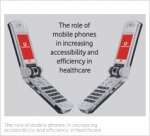
In a lengthy and thorough article entitled Mobile phones and health, The Economist, reports on a study carried out by Rifat Atun and his colleagues at Imperial College, London, rounding up 150 examples of the use of text-messaging in the delivery of health care. "These uses fall into three categories: efficiency gains; public-health gains; and direct benefits to patients by incorporating text-messaging nto treatment regimes. The study, funded by Vodafone.
20:26 Posted in Wearable & mobile | Permalink | Comments (0) | Tags: Positive Technology






